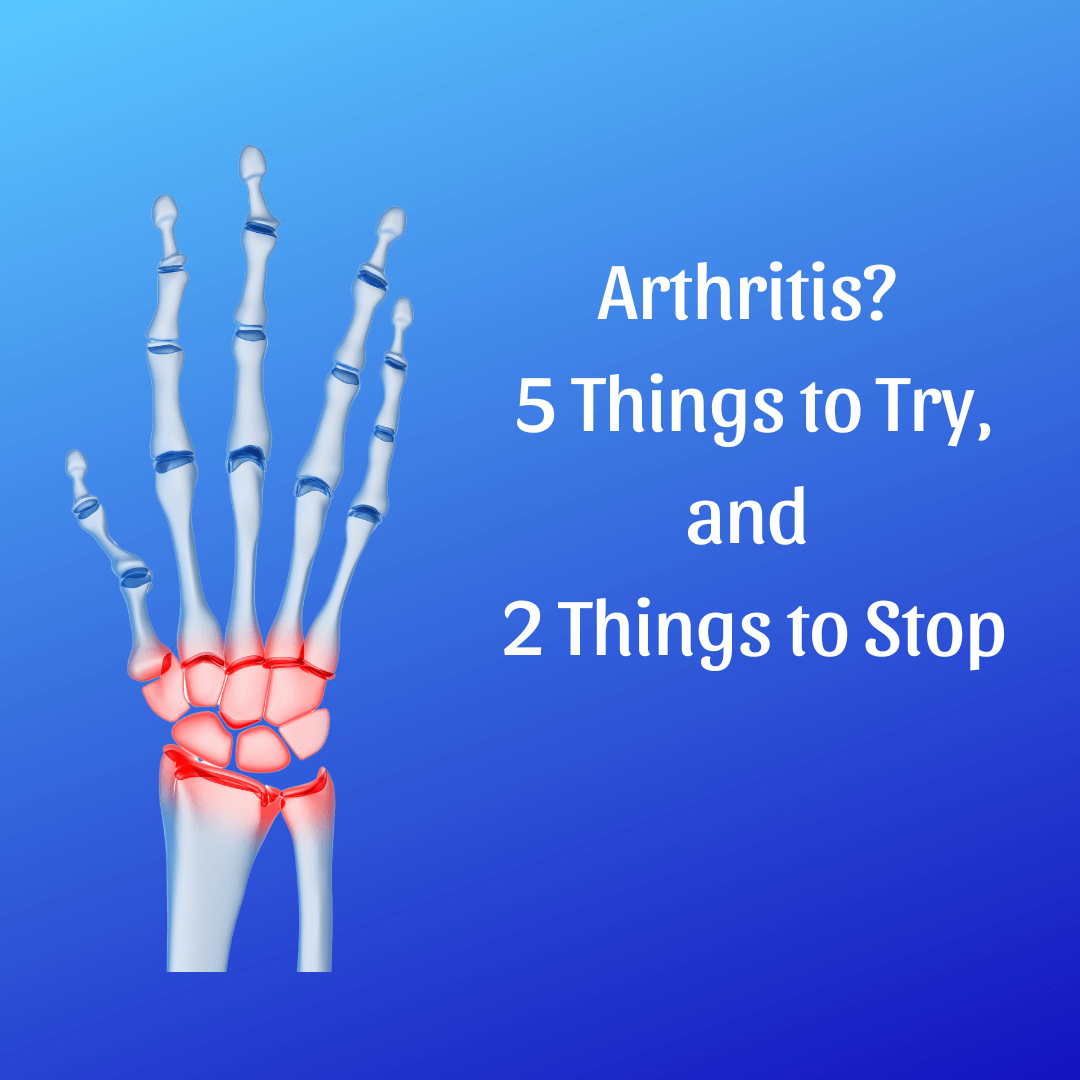
Arthritis? 5 Things to Try, and 2 Things to Stop
If you have been diagnosed with arthritis, welcome to a large club; 20% of Canadians have arthritis, and it is Canada’s most common chronic disease. Technically though, arthritis isn’t one disease. The term “arthritis” comes from Latin and translates as “inflammation of the joint”. Arthritis is a symptom in over 100 different illnesses, and often comes with swelling, pain, stiffness, and a reduced range of motion. Osteoarthritis, rheumatoid arthritis, lupus, gout, and fibromyalgia are some the most common types of arthritis. Symptoms vary by type of disease, and can include fever, fatigue, eye problems, feeling flu-like, and emotional distress. It is important to understand what kind of arthritis you have, what symptoms you can expect, and how to treat them; your healthcare provider can point you to reliable information.
These 5 things will help all arthritis conditions:
- Get regular exercise. You might think that you should avoid exercise, but it is a critical part of staying healthy. Regular exercise strengthens the muscles around the joints and supports your sleep and energy levels. Without some exercise your joints will actually become more stiff and painful. You may need to adjust your exercise to ensure it is meeting your goals and not causing too much pain; a physiotherapist is a great resource to help set up an exercise program.
- Get your sleep. Pain and sleep can easily create a vicious circle: people with pain find it hard to sleep, but people without enough sleep tend to experience greater pain. Review general recommendations on good sleep habits (i.e., have a regular bedtime, avoid stimulants like tea and coffee after noon, create a comfortable bedroom just for sleeping etc.) Some folks find it helpful to take a hot shower before bed, do some gentle stretching, or use an electric blanket. Whatever you do, don’t skimp on sleep!
- Manage your stress. Everyone has stress but the addition of a chronic disease can add an extra layer of stress. Unfortunately, stress isn’t good for arthritis. It causes muscle tension which can increase the pain. Stress can even trigger an episode of arthritis. If you haven’t found skills to manage your stress yet, it is time to try some new strategies. Meditation, yoga, therapy, journalling, and guided relaxation are all worth trying. You may have to learn how to prioritize your workload, how to ask for help, and how to say no to things that add to your stress level.
- Let your food be medicine. Researchers have proven that many foods have “anti-inflammatory” properties, which make them helpful to arthritis sufferers. Green tea, berries, and fish high in Omega-3 are all considered anti-inflammatory, and so are several vegetables (like broccoli, cauliflower, Brussels sprouts and mushrooms). Olive oil is a great cooking oil, and ginger and turmeric are anti-inflammatory spices. You can research anti-inflammatory diets, or you might start with the most famous one, the Mediterranean diet.
- Work with your doctor to develop a plan for flares. A “flare” is an episode where you experience a worsening of symptoms, and they are to be expected. By keeping a record of your flares you may be able to figure out what triggers them in hopes of avoiding them over time. When flares happen, you must be gentle with yourself. Get lots of rest and ask for help if you need it. Some people find heat helps reduce the pain, and cold packs may reduce swelling and inflammation. Work with your healthcare provider to see how medication fits into your plan for flares.
In addition, there are two things to stop:
- Quit smoking. If you’ve been looking for a reason to quit, you just found it. Smoking is detrimental to your bones and joints, and this damage can make your arthritis worse.
- Skip “high impact” activities if they cause joint pain. You’ll get to know your own limitations, but you may need to replace running and jumping with lower impact exercise like biking, walking, or using an elliptical trainer. Again, a physiotherapist can help.
Adjusting to arthritis can take time, particularly as you learn how your body responds to your type of arthritis. Be patient with yourself, ask for help if you need it, and educate yourself on arthritis management techniques.
For more reading on this topic:
“How Do Exercise and Arthritis Fit Together?” Mayo Clinic, Mayo Foundation for Medical Education and Research, 1 Dec. 2020, https://www.mayoclinic.org/diseases-conditions/arthritis/in-depth/arthritis/art-20047971
“Arthritis Pain and Sleep.” WebMD, WebMD, https://www.webmd.com/osteoarthritis/features/arthritis-pain-sleep.
. Elizabeth Scott, PhD. “18 Highly Effective Stress Relievers.” Verywell Mind, https://www.verywellmind.com/tips-to-reduce-stress-3145195.
Bone, Muscle and Joint Team. “10 Foods That Help Ease Your Arthritis Pain.” Cleveland Clinic, Cleveland Clinic, 11 Feb. 2021, https://health.clevelandclinic.org/top-10-foods-power-ease-arthritis-pain/.
“Managing an Arthritis Flare: Arthritis NSW.” Arthritis New South Wales, 25 Feb. 2020, https://www.arthritisnsw.org.au/managing-an-arthritis-flare/#:~:text=Managing%20an%20Arthritis%20Flare%201%20Plan%20Ahead.%20Plan,variety%20of%20options%20available%20for%20support%20and%20information.
“Daily Living – Smoking and Arthritis.” Home, https://arthritis.ca/support-education/online-learning/daily-living/smoking-and-arthritis.
“Managing Arthritis Pain.” Mayo Clinic, Mayo Foundation for Medical Education and Research, 6 Aug. 2022, https://www.mayoclinic.org/diseases-conditions/arthritis/in-depth/arthritis/art-20046440.


